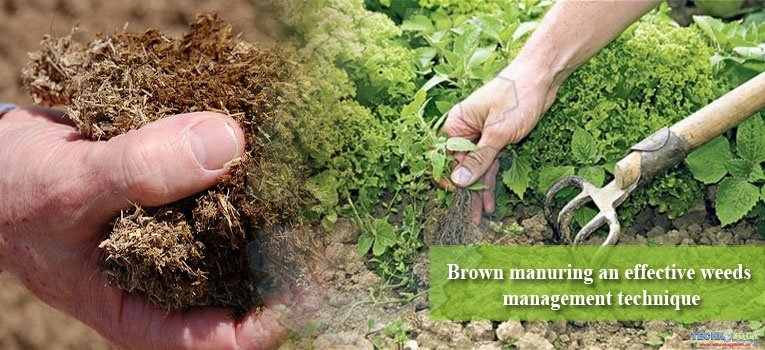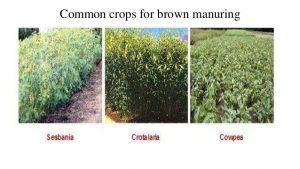Brown Manuring Weeds: Pakistan is an agriculture country and its economy depends upon agriculture and its products and by-products. Major crops of Pakistan are wheat (Staple food of country), rice, maize, cotton and sugarcane.

Pakistan is facing a loss of >6.5 billion PKR in major crops due to occurrence of plants diseases and pests. Among pests, weeds ensures more losses than insects and disease.Effective control of weeds are foremost challenge for the farmers growing rice especially direct seeded rice. This is due to shifting of weeds flora to competitiveness of sedges and grasses
- Why it is necessary to control the weeds?
Weeds are major yield declining biotic constraint. They compete with crops for nutrients, space, moisture and light. This weed-crop competition reduces the yield up to 50-60% in DSR. There could be more lossees in direct seeded rice because the weed and rice are at same stages.
Weeds also reduce the growth of crop plants by the release of allelochemicals through their roots. The competition between various weed density and rice causes 12-90% decline in rice yield. Weeds also cause more than 50% yield reduction in maize.
- Method used to control the weeds:
Different methods of weeds management are used like manual weeding, mulching and use of herbicides. Manual weeding is costly and is difficult to use due to unavailability of labor. When time of weeding meet with other farm operations, the most economic, effective and applied way of controlling weed is chemical control. Now a days more than 40 types of herbicides are used in Pakistan and import of agrochemicals are gradually increasing every year.
Due to continuous and unbalanced use of weedicides, resistance has been developed in weeds. This is leading to ineffectiveness of herbicides. Moreover, constant use of herbicides leads to persistence of chemicals in their produce and food chain which cause cancer in human when they use. Due to over dependence on herbicides, there are severe ecological problems. It disturb the micro-climate of soil hence effecting the microbial activities.
- Brown manuring:
Cultural method of controlling weeds helps us to decrease the competition between weeds and crops. In this perspective, brown manuring is an effective strategy for weed management. Brown manuring is a “no-till” form of green manuring involving the use of herbicide to kill the crops before the flowering.
It suppresses the weeds especially broad-leaved weeds without destroying the soil physio-chemical properties and microbial activities. It is also helpful in increasing the soil nitrogen and moisture conservation. The dried biomass on the soil surface reduces the interception of sun rays thus decreasing the evaporation.
Brown manuring in different crops
Brown manuring can be practiced by raising crops like sesbania (jantar) as mixed or inter crop in main crop and killing of brown manure crop by applying herbicides. It can be used to control weeds in different crops including rice, maize, wheat and sugarcane. This technology reduces the 50% weeds density without effecting the rice yield.
- Brown manuring in Direct Seeded Rice (DSR):
Rice is an important crop of subtropical and tropical areas of world. It is staple food of 70% population of world. Rice is 2nd staple food of Pakistan and is also 2nd major export of Pakistan after cotton. Basmati rice of Pakistan is of great importance in international market. In Pakistan, it is grown more than 2.89 million hectares of land and its production is 7.44 million tonnes.
DSR ,Direct Seeded Rice, is a best substitute of anaerobic rice. It saves 29 per cent of cost, require less labor (29%) and 30-50% irrigation water saving than transplanted crop. Brown manuring in rice involves growing of sesbania or other brown manure crops in inter-row space of 30 cm after two rice rows of 15 cm. Sesbania is semi-aquatic plant belonging to leguminous family. It has symbiotic association with Gram –ve rhizobia which produce nodules on roots.
In brown manuring, 20-25 kg/ acre seed of sesbania is applied @ 3-4 DAS (days after sowing) of rice. The growth of sesbania is faster than weeds. It dominates on weeds thus reducing the interception of sunlight, hence their growth reduces. After 25 to 30 DAS, sesbania is killed by spraying post-emergence herbicide i.e. 2, 4-D ethyl-ester @ 1 kg/ha.
This leads to the loss of chlorophyll and the color of crop becomes brown hence called brown manuring. These brown leaves fall on soil and its decomposition rate is very fast. Thus providing organic carbon, nitrogen and dry matter accumulation. This practice reduces the weed population up to 50%. Brown manuring act as surface mulch. Therefore, increases the soil moisture conservation along with the supply of 10-15 kg of nitrogen per hectare upon decomposition.
- Brown manuring in irrigated maize:
After rice, the maize is important crop and also called the queen of cereals. In Pakistan, Maize is grown on more than 1.23 million hectares of land and its production was 5.7 million tonnes. Maize contribute 2.4% in agriculture value added and 0.5% to GDP. Production of maize reduced during the last year. One of main yield limiting factor was invasion of weeds which reduced the maize yield up to 40%.
Brown manuring is effective weeds management technique practiced in maize field. Maize is grown at their recommended plant to plant (25 cm) and row to row distance (60 cm). Sesbania was sown as inter-crop in between the rows of maize crop. The sowing time of sesbania and maize was same.
After three days of sowing,pre-emergence weedicide was applied Maize and sesbania were together in field for 35 days. Afterward, sesbania was killed with foliar application of 2, 4-D @ 0.5 kg ha-1. The plant biomass remained on the soil acting as mulch thus preventing loss of water due to evaporation. Shade effect and fast growing characteristics of sesbania reduced the weeds pressure.
- Brown manure crops

Sesbania, sun hemp and cow-pea are used for brown manuring. It is because of the reason that these crops not only providing nitrogen but also add organic matter in the soil.
Following are three main advantages of using legumes crops for brown manuring.
- It competes with weeds thus reducing their growth by taking more available resources and high growth rate.
- Reducing the nitrogen requirement of plant as legumes acquire nitrogen from air through bacteria present in their nodules.
- Preventing the loss of water due to evaporation, hence help in water conservation.
Crops other than legumes can also be grow. But farmer not preferred as they only improve soil organic matter contents. Brown manuring is the best practice for effective weed control. It suppresses the weeds pressure up to 50% without damaging the soil physio-chemical properties.
It involves the reverting of crop materials to soil. Thus enhancing the soil health and improving the physical properties of soil. Due to more soil moisture conservation and effective control of weeds, benefit-cost ratio increases.
